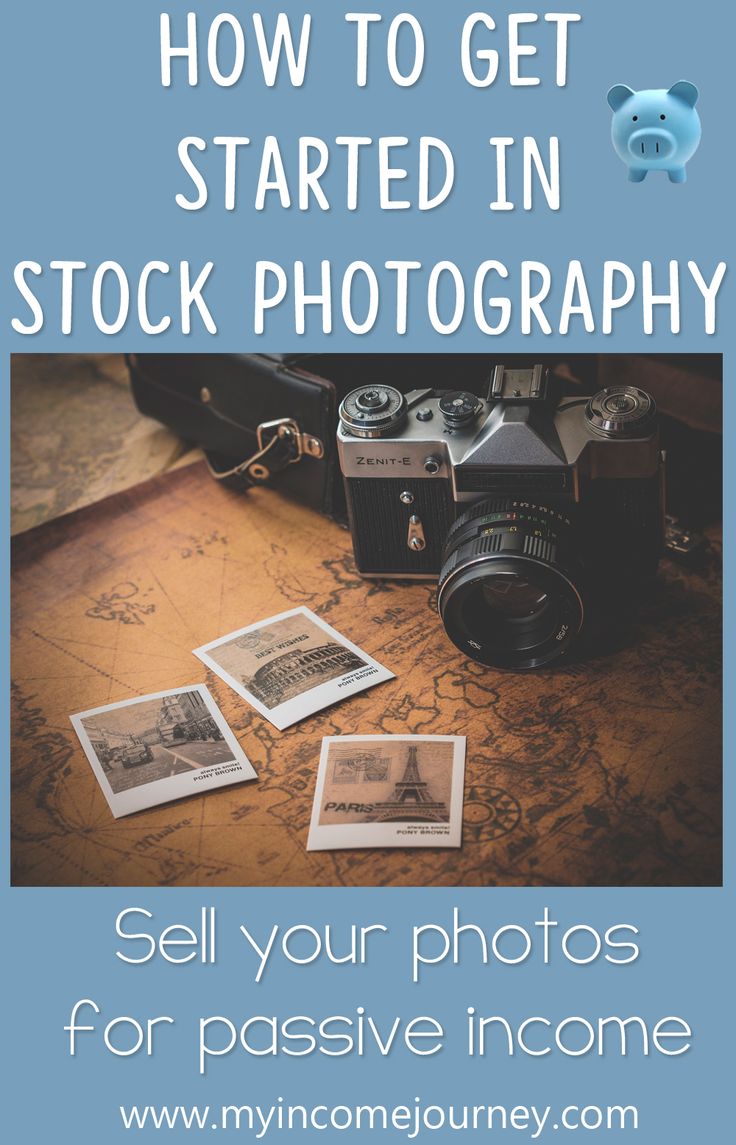Have you ever snapped a stunning photo and wondered how to turn that passion into profit? Selling photos on Getty Images could be your golden ticket! With millions of users relying on stock photography for their projects, it’s an excellent platform to showcase your creativity and make some cash along the way. In this post, we’ll explore the ins and outs of stock photography and provide tips on how you can maximize your earnings through Getty Images. Ready to embark on your photographic journey? Let’s dive in!
Understanding Stock Photography

Stock photography is essentially a collection of photographs that can be licensed for specific uses, whether for commercial projects, marketing campaigns, or editorial content. It’s a fantastic way for photographers to sell their work without the hassle of negotiating contracts with individual clients. When you upload your images to stock sites like Getty Images, they become available to a global audience, and you earn money each time someone uses your photo.
Here are some key aspects to help you grasp the concept of stock photography:
- Types of Stock Photos: There are two main types of stock photography:
- Royalty-Free (RF): These images can be bought and used without additional fees after the initial purchase.
- Rights-Managed (RM): These images require buyers to pay based on usage, duration, and exclusivity.
- Market Demand: Always keep an eye on current trends. Seasonal themes, business images, and lifestyle shots are usually in high demand.
- Quality Matters: Your photos need to be technically sound and visually appealing. Invest in good equipment and editing software to produce high-quality images.
- Licensing Agreements: Understand the terms and conditions of the stock agency you’re working with. This will help you know how you can sell your photos and what rights you retain.
By understanding these fundamentals, you can navigate the world of stock photography more effectively and prepare yourself for a successful journey selling photos on Getty Images.
Also Read This: Unflatten an Image in Photoshop
Creating High-Quality Images

Creating high-quality images is essential if you aim to sell on Getty Images or any stock photography platform. Think about it this way: your photos are competing with countless others. To stand out, you need to deliver visually stunning images that evoke emotions and tell a story.
Here are some essential tips for capturing high-quality imagery:
- Invest in Good Equipment: While you don’t need the latest and most expensive camera, investing in a decent DSLR or mirrorless camera can significantly improve your photo quality. Don’t forget about lenses that fit your style, too!
- Understand Lighting: Good lighting can make or break your shots. Natural light during the golden hour (sunrise or sunset) is often the most flattering. Experiment with different lighting conditions to see what works best for you.
- Focus on Composition: Utilize the rule of thirds, leading lines, and framing techniques to create visually appealing images. It’s all about guiding the viewer’s eye to your subject!
- Edit Your Photos: Post-processing tools like Adobe Lightroom or Photoshop can help enhance your images. Just remember to keep edits realistic; overly edited photos can turn potential buyers away.
- Stay Relevant: Pay attention to current trends. Research what types of images are doing well on Getty Images and create similar content. Think about seasonal events, popular themes, and emerging industries.
By focusing on these aspects, not only will you maximize your chances of getting accepted into Getty Images, but you'll also attract more potential buyers, enhancing your overall earnings!
Also Read This: How to Contribute to Adobe Stock
Joining Getty Images
Joining Getty Images can feel like a big step, but it’s an exciting opportunity to showcase your work to a global audience. Here’s a friendly guide on how to get started on this platform.
First things first, you’ll need to follow these steps:
- Visit the Getty Images Contributor Page: Head over to the Getty Images website and find their contributor section. This is your gateway to signing up!
- Fill Out the Application: You'll be required to provide some personal information, including your email address, portfolio link, and a brief bio. Make sure to showcase your unique style and what makes your photography special.
- Submit a Sample of Your Work: Often, you'll need to upload 3-5 images that exemplify your best work. Remember, these should be high-quality photos representative of your style.
- Understand the Licensing Agreement: Familiarize yourself with Getty’s licensing terms. It’s crucial to know how your images will be used and how you'll be compensated.
- Await Approval: Once you've submitted your application, it’s a waiting game. Getty’s team will review your submission and notify you of their decision.
Upon acceptance, you can start uploading your images to the platform. Keep in mind, it's vital to stay consistent with uploading new content to keep your portfolio fresh and engage a broader audience. Happy shooting!
Also Read This: Finding Free Getty Images for Your Projects
5. Uploading Your Photos
Once you've taken stunning photographs and are ready to share them with the world, the next step is uploading your photos to Getty Images. This part can seem daunting, but with a little guidance, you'll find it’s quite straightforward.
First, make sure your images meet Getty's quality standards. High-resolution files are essential, so always opt for images that are at least 4MP in size. Getty rejects images that are blurry, grainy, or poorly composed, so take the time to edit your photos professionally using software like Adobe Lightroom or Photoshop.
Next, head over to the Getty Images Contributor portal. If you haven’t already created an account, you'll need to sign up, which is a breeze! Here’s a simple process:
- Log into your Contributor account.
- Navigate to the 'Upload' section.
- Select the images you’d like to upload. You can do this in bulk.
- Review any warnings about quality or file size before proceeding.
After uploading, you’ll have to fill out some metadata for each image. This includes:
- Title: The name of your photo.
- Description: A brief overview of what the image depicts.
- Keywords: Relevant tags to help potential buyers find your images.
Once everything is filled out, hit that submit button! Remember, uploading is just the beginning. Now, it’s about marketing your images effectively, which we’ll touch on later. Happy uploading!
Also Read This: Creating an Image File
6. Setting the Right Prices
When it comes to stock photography, setting the right prices can make or break your earnings. After all, you want your work to be accessible enough to attract buyers but also priced to reflect its value. So how do you find that sweet spot?
Getty Images has a predefined pricing model based on several factors, including:
- Usage Rights: What are buyers using your photos for? Editorial, commercial, or personal uses?
- Licensing: Are they purchasing a standard or extended license? Extended licenses typically fetch higher prices.
- Image Quality: High-quality images may warrant a higher price.
One effective strategy is to research similar images in the platform. Check out how much others are charging for similar shots and use that as a benchmark. Here’s a simple approach to set your prices:
| Category | Standard License | Extended License |
|---|---|---|
| Editorial | $50-$150 | $100-$300 |
| Commercial | $75-$200 | $150-$400 |
Keep in mind that you can adjust prices as you gain experience and insight into market demand. Don't undervalue your work, but also be open to making adjustments based on buyer feedback. Essentially, it's all about finding that perfect balance that attracts buyers without undervaluing your talent. Happy pricing!
Also Read This: How to Make Money on EyeEm: A Step-by-Step Guide
7. Promoting Your Work
Promoting your photos on Getty Images is crucial to increasing visibility and maximizing your earnings. While Getty Images provides a platform, promoting your own work can help you stand out among thousands of photographers. Here’s how you can effectively promote your collection:
- Social Media: Use platforms like Instagram, Twitter, and Facebook to showcase your portfolio. Share behind-the-scenes shots, tips on photography, and highlights of your best-selling images.
- Photography Websites/Blogs: If you have a personal website or a blog, use it to feature your work. Write posts about your photography journey or the stories behind your images, adding links to your Getty portfolio.
- Email Newsletters: Create a mailing list and send updates to your subscribers. Highlight your recent work, sales achievements, and upcoming projects. This keeps your audience informed and encourages them to check out your new listings.
- Networking: Connect with other photographers and creatives. You can collaborate on projects or pair up for online seminars on stock photography. This can broaden your audience.
- Online Advertising: If your budget allows, consider running targeted ads on social media platforms to reach a wider audience interested in photography or visual content.
Remember, consistency is key. Regularly update your promotions as you add new photos to your Getty Images collection. By actively engaging with your audience, you can create a following that enhances the potential for sales.
Also Read This: how much does one adobe stock image cost in credit
8. Tracking Your Sales and Earnings
Understanding how your images are performing on Getty Images is essential to maximizing your stock photography earnings. Getty Images provides tools to help you track sales, but developing a system tailored to your needs can offer deeper insights. Here’s how you can track your sales and earnings effectively:
- Use Getty Images Analytics: Log in to your contributor account and access the analytics provided. This feature can show you which images are performing well, giving you insights into trends.
- Maintain a Tracking Spreadsheet: Create a simple spreadsheet to monitor your sales. Include columns for Image Name, Sale Date, Revenue, and License Type. This will help you analyze which types of images are more lucrative over time.
- Review Earnings Reports: Regularly review the earnings reports provided by Getty. This will help you see your monthly earnings and identify peak sale periods or successful promotional strategies.
- Assess Customer Feedback: Pay attention to any feedback or usage reports regarding your images. This can help inform your future shoots and enhance the types or themes of images you create.
By keeping a close eye on your sales and earnings, you can adapt your strategies, focus on popular themes, and ultimately maximize your profits from stock photography on Getty Images. Remember, knowledge is power when it comes to improving your creative business!
Also Read This: How to Download Things from Behance
9. Tips for Ongoing Success
Once you’ve set out on your journey of selling photos on Getty Images, it’s essential to maintain a strategy that ensures ongoing success. Here are some practical tips to keep your momentum going:
- Stay Updated with Trends: Stock photography is not static; it's essential to keep an eye on what’s trending. Regularly check Getty Images’ “New Releases” or “Trending” sections. Capture images that align with current events, seasonal themes, or trending aesthetics.
- Diversify Your Portfolio: A wide-ranging portfolio attracts different customers. Experiment with various styles, subjects, and formats to cater to a broader audience. For instance, you might want to try your hand at lifestyle, food photography, or abstract concepts.
- Optimize Metadata: Properly tag and describe your photos. Use relevant keywords that potential buyers might be searching for. Think about different ways someone might describe your photo.
- Engage with the Community: Join online forums and social media groups where photographers share their experiences on stock photography. Engaging with peers can provide you with valuable insights and new ideas.
- Continuously Improve Your Skills: Keep honing your photography skills through workshops, tutorials, and practice. The better your skills, the more likely you are to take standout images that can fetch higher prices.
- Monitor Your Sales Analytics: Regularly review your sales analytics on Getty Images to understand what’s performing well. This data can guide your future shoots, ensuring you focus your efforts where they matter.
With these tips in hand, you're well on your way to cultivating a successful stock photography career. Keep pushing your creative boundaries, and remember—successful selling is an ongoing journey.
10. Conclusion
In conclusion, selling photos on Getty Images is more than just uploading pictures and hoping for the best; it’s about strategy, creativity, and persistence. By understanding the platform, creating high-quality images, and continually evolving your approach, you can maximize your earnings effectively.
Here’s a quick recap of what we covered:
| Key Takeaways |
|---|
| Understand Getty Images' requirements and submission guidelines. |
| Focus on creating high-quality and original images. |
| Optimize your keywords and metadata for better visibility. |
| Engage with the photography community for support and inspiration. |
| Regularly review your analytics to refine your strategy. |
As you embark on this exciting venture, remember that persistence is key. Keep creating, learning, and adapting to the market. Your unique perspective is valuable—share it through your photos, and the earnings will follow. Happy shooting!
 admin
admin








